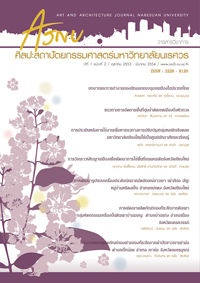การวิเคราะห์สัณฐานเมืองเพื่อพัฒนาการใช้พื้นที่ถนนคนเดินจังหวัดเชียงใหม่
Main Article Content
Abstract
บทความนี้เป็นการใช้ชุดทฤษฎีและเทคนิค Space Syntax ในการศึกษาการใช้พื้นที่สาธารณะ กรณีศึกษาถนนคนเดินจังหวัดเชียงใหม่ โดยชุดทฤษฎีและเทคนิค Space Syntax นั้นสามารถสร้างแบบจำลองความสัมพันธ์ของโครงข่ายเมือง ร่วมกับการเก็บข้อมูลในภาคสนาม เพื่อนำมาวิเคราะห์สัณฐานของเมืองเชียงใหม่ โดยการศึกษามีสมมติฐานว่าสัณฐานของเมืองเชียงใหม่ส่งผลต่อการใช้พื้นที่สาธารณะบริเวณถนนคนเดิน โดยวิธีการวิเคราะห์ Space Syntax จะช่วยให้เข้าใจถึงระบบความสัมพันธ์ เหตุปัจจัยที่ส่งผลต่อความเข้าใจเมืองและการใช้พื้นที่เมือง จากผลการวิเคราะห์สัณฐานเมืองเชียงใหม่สามารถจำแนกระบบโครงข่ายการสัญจรของเมืองเป็นสองรูปแบบได้อย่างชัดเจน โดยแบบแรกเป็นโครงข่ายย่อยมีลักษณะการสัญจรที่เป็นเส้นทางสั้นและมีจำนวนมาก เป็นโครงข่ายการสัญจรที่ผู้ใช้เป็นคนในพื้นที่เป็นหลัก โครงข่ายนี้มีค่าการฝังตัวต่ำคือมีอัตราการสัญจรผ่านน้อย โครงข่ายอีกแบบเป็นโครงข่ายขนาดใหญ่ที่เป็นโครงข่ายหลักของเมือง มีลักษณะเป็นเส้นทางที่กว้างและยาวต่อเนื่องเป็นเส้นตรงจดจำได้ง่าย โครงข่ายนี้มีค่าการฝังตัวสูงคือมีอัตราการสัญจรผ่านที่มากกว่า ทั้งยังพบว่าสัณฐานของเมืองเชียงใหม่ในภาพรวมมีลักษณะเด่นคือมีค่าสัมประสิทธิ์การผสานที่ดีมาก ประชากรสามารถเลือกใช้เส้นทางสัญจรได้หลากหลายทั้งในระดับย่านและระดับเมือง แต่มีลักษณะด้อยคือมีค่าสัมประสิทธิ์ความสามารถในการทำความเข้าใจเมืองที่ต่ำ หมายความว่าคนที่เข้ามาใช้พื้นที่เมืองสามารถรับรู้และเข้าใจระบบเส้นทางของเมืองได้ยาก ทำให้มีปัญหาต่อการเลือกใช้เส้นทางในการสัญจรที่เหมาะสมได้ แต่เมื่อพิจารณาเฉพาะพื้นที่ส่วนถนนคนเดินที่เลือกทำการศึกษาพบว่าเป็นบริเวณที่มีค่าสัมประสิทธิ์การผสานและค่าสัมประสิทธิ์ความสามารถในการทำความเข้าใจเมืองสูง หมายความว่าพื้นที่ส่วนนี้มีศักยภาพที่ทำให้ผู้คนเข้าถึงได้ง่ายไม่ซับซ้อนสามารถสัญจรมาได้หลายทางซึ่งเหมาะสมสำหรับถนนคนเดินที่ศึกษานี้ และจากการเก็บข้อมูลในพื้นที่ถนนคนเดินทำให้เห็นอัตราการสัญจรผ่านของคนเดินเท้าซึ่งมีความสอดคล้องกับผลที่ได้จากการใช้ Space Syntax นั่นคือพื้นที่ที่มีสัมประสิทธิ์ในการทำความเข้าใจเมืองสูง ก็เป็นพื้นที่ที่คนเดินเท้าเลือกเป็นเส้นทางเดินหลักมากกว่าพื้นที่ที่มีสัมประสิทธิ์ในการทำความเข้าใจเมืองที่มีค่าต่ำกว่า เนื่องจากถนนคนเดินในปัจจุบันเกิดจากนโยบายของภาครัฐโดยเป็นการกำหนด สถานที่ วัน เวลาเพื่อให้เกิดกิจกรรมค้าขายแบบถนนคนเดิน ซึ่งกิจกรรมลักษณะนี้จำเป็นต้องเลือกพื้นที่ที่สามารถจดจำและ ทำความเข้าใจได้ง่าย มีศักยภาพในการเข้าถึงสูงเพื่อให้สะดวกต่อผู้ที่เข้าไปใช้งาน ผลการศึกษาทำให้เห็นว่าถนนสายหลักของถนนคนเดินในปัจจุบันมีความเหมาะสมกับสัณฐานของระบบเมือง แต่ถนนสายย่อยยังไม่เหมาะสมเท่าที่ควรทำให้การใช้งานในปัจจุบันของพื้นที่ถนนคนเดินยังไม่สามารถใช้งานได้เต็มศักยภาพ ซึ่งถ้ามีการปรับเลือกการใช้เส้นทางใหม่ให้มีความเหมาะสมกับสัณฐานของเมืองจะสามารถสนับสนุนกิจกรรมถนนคนเดินให้ดีได้ยิ่งขึ้น
Urban Morphological Analysis for Chiang Mai Walking Street Space Utilization Improvement.
This paper presents part of the research implementing Space Syntax theory and techniques in the field of public space utilization of Chiang Mai Walking Street. Using Space Syntax Theory and techniques, urban network was simulated into relationship models. These model were used as main information accompanying with the field study in order to analyze Chiang Mai City Morphology. The study is guided by the assumption that space syntax analyses can help understanding the valuable information about how well Chiang Mai Walking Street is integrated into the urban morphology and how that influences to its understandability and usability for the public. From the analysis, it reveals that Chiang Mai urban network compounds of a dual form. Local network, the first one, is the street network comprises the amount of short and small scale streets usually used by local people. This form of network has low ‘Integration Value’, in other words, they are streets with less flow of traffic. The other form is global network which is the main network of the city. This network comprises wide, long and straight streets with a greater flow of traffic and the integration value. In terms of urban morphology itself, Chiang Mai has the advantages of having very high ‘Synergy Coefficient’ both locally and globally which means that people have great alternatives of route choice. Unfortunately, its ‘Intelligibility Coefficient’ is quite low, this value shows that people might have difficulty in understanding and remembering the street network. However, picking up only the study area, Chiang Mai Walking Street area has high values of both ‘Synergy Coefficient’ and ‘Intelligibility Coefficient’ and this suit well with its function and characteristic. Moreover, the result from the field study reviews that pedestrian walk-through rate in Chiang Mai Walking Street area have the same tendency with the result acquired from Space Syntax techniques. The streets with high ‘Intelligibility Coefficient’ value contained a larger number of pedestrians than the one with low ‘Intelligibility Coefficient’ value. For this type of activity, accessibility can play an important role as a supportive factor. The easier it is to reach a street, the more popularly it should be used. The analyses shows that the main lines of the walking street are now on the highly integrated streets, this brings a number of tourists and local people into the area of activities. While the main lines are suitably placed, the sub-lines are facing a problem of low integration and less number of people. The finding of this study provide more information for urban design to pick up more morphologically suitable street for Chiang Mai Walking Street.

